10 Ducks with Red Eyes You’ll Want to See for Yourself
There’s something almost mesmerizing about a duck with red eyes. Whether they glow like tiny rubies in the sunlight or flash briefly across the water’s surface, these vivid eyes have a way of catching your attention. Far from being strange or spooky, red eyes are a natural and fascinating trait found in several duck species around the world—from the sleek pochards of Europe and Asia to the bold, rosy-billed beauties of South America.
Eye color in ducks, much like in other birds, is shaped by a mix of biology and adaptation. The red tones often come from carotenoid pigments or from light reflecting through fine blood vessels in the iris. In some species, that fiery color intensifies during breeding season, turning their gaze into part of their courtship display. It’s a small detail that tells a big story—about age, health, and even the environment the duck calls home.
So, if you’ve ever noticed a flash of red eyes glinting from a quiet pond or wetland, you’ve likely caught a glimpse of one of nature’s most striking design choices. Let’s meet a few of these remarkable red-eyed ducks and discover what makes each one so special.
- 1. Canvasback (Aythya valisineria)
- 2. Rosy-billed Pochard (Netta peposaca)
- 3. Wood Duck (Aix sponsa)
- 4. Chestnut Teal (Anas castanea)
- 5. Grey Teal (Anas gracilis)
- 6. Cinnamon Teal (Anas cyanoptera)
- 7. Red-crested Pochard (Netta rufina)
- 8. Red-breasted Merganser (Mergus serrator)
- 9. Common Pochard
- 10. White-winged Duck (Asarcornis scutulata)
1. Canvasback (Aythya valisineria)
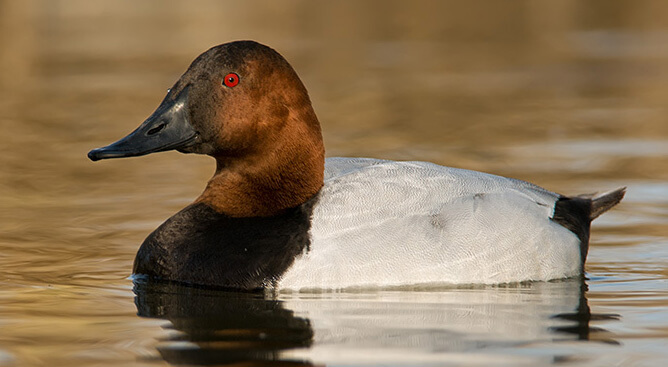
If you spot a duck with glowing red eyes and a long sloping head, there’s a good chance it’s a Canvasback.
The male’s deep red eyes stand out beautifully against his reddish-brown head and bright white body. He looks tall and proud, often called the “aristocrat of ducks” for his elegant shape and calm posture.
Females don’t have such strong colors—they’re mostly soft brown—but they share that same long, graceful head shape.
Canvasbacks are diving ducks, which means they dive deep under the water to eat roots and plants at the bottom of lakes and wetlands. They spend their winters on big lakes and bays, often in large flocks that shimmer in the sunlight.
2. Rosy-billed Pochard (Netta peposaca)
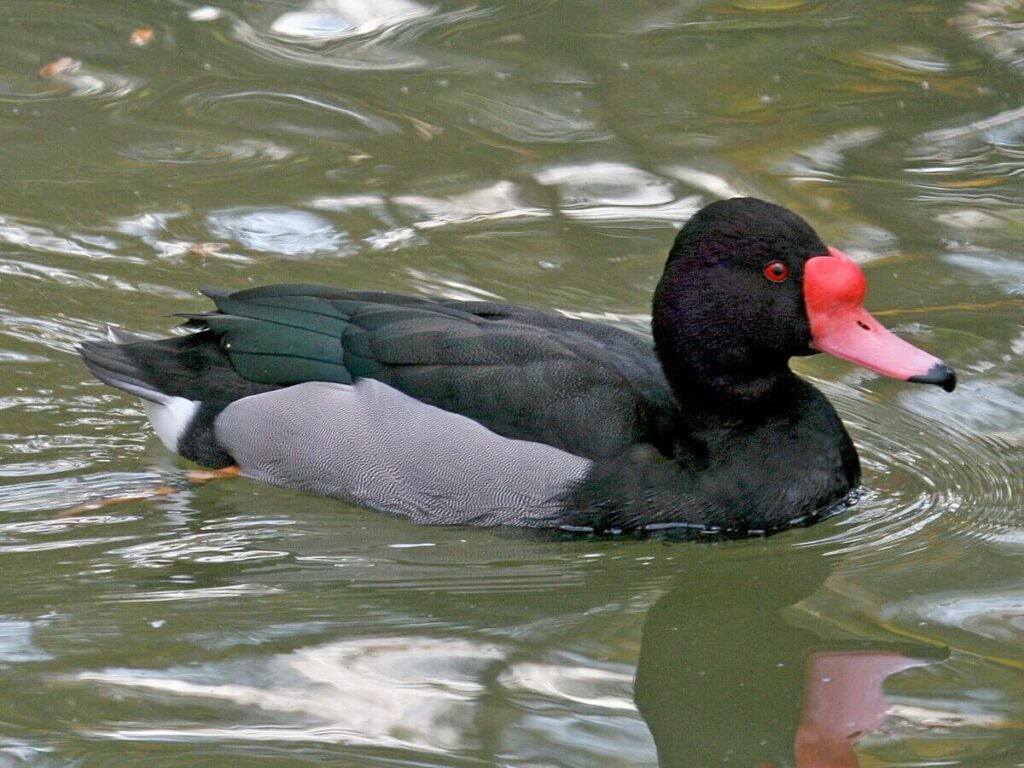
The male Rosy-billed Pochard is a showstopper: deep red eyes, a glossy purplish-black head, and a bright red bill topped with a rounded knob that glows even more during mating season.
The name peposaca comes from the Guaraní word meaning “showy wings,” and indeed, this South American native is nothing short of spectacular when in flight, flashing its broad white wing stripe for all to see.
Found across Argentina, Chile, Uruguay, Paraguay, and southern Brazil, this duck prefers calm lakes and marshes, feeding mostly on seeds, roots, and aquatic plants.
Though technically a diving duck, it often behaves like a dabbling duck, gently tipping forward to feed near the surface.
The females are more modestly dressed in brown with bluish-gray bills, but they share that same graceful poise that makes this species a favorite among birdwatchers across the southern continent.
3. Wood Duck (Aix sponsa)
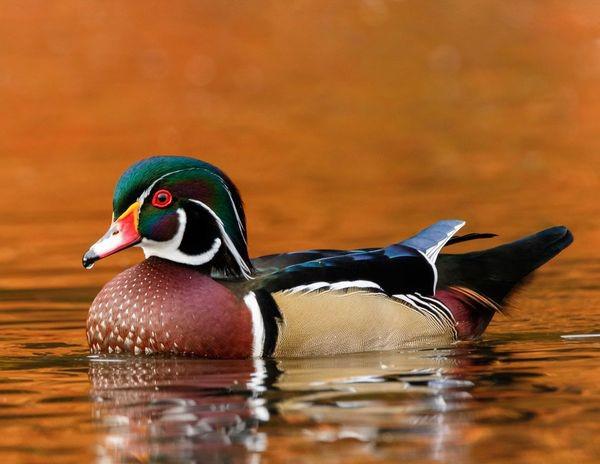
The Wood Duck is one of the most colorful ducks you’ll ever see, and its bright red eyes make it even more striking.
The male has a shiny green and purple head with white stripes and patterns that almost look painted on. His red eyes seem to sparkle, giving him a lively and curious look.
The female is softer in color, mostly brown with a white ring around her eye, but she’s just as beautiful in her own quiet way.
Wood Ducks like wooded swamps, ponds, and rivers, and they often nest in tree holes near the water. If you’re lucky, you might see one perched on a branch or gliding gracefully across a calm pond.
4. Chestnut Teal (Anas castanea)
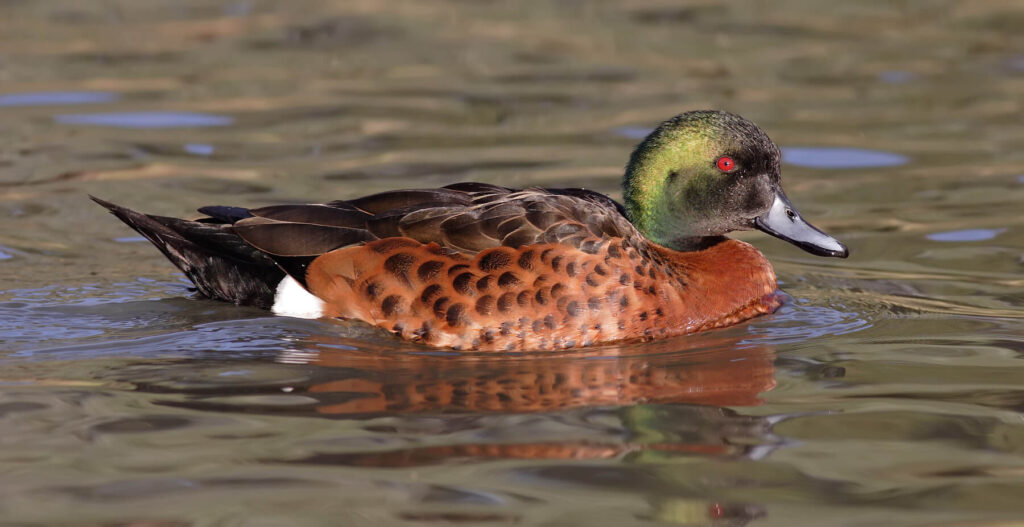
The Chestnut Teal is easy to recognize by its red eyes, which both males and females share.
The male is a showy little duck with a shiny green head and rich chestnut sides, while the female is brown and softly patterned, blending in well with her surroundings. Even though she looks plainer, those red eyes still give her away.
Chestnut Teals live mostly around coastal wetlands and estuaries, often where salt and fresh water mix. They’re tough little ducks, happy in salty lagoons as long as there’s fresh water nearby to drink.
Watch for their flash of green and white on the wings when they take off—it’s a beautiful sight for any birdwatcher.
5. Grey Teal (Anas gracilis)
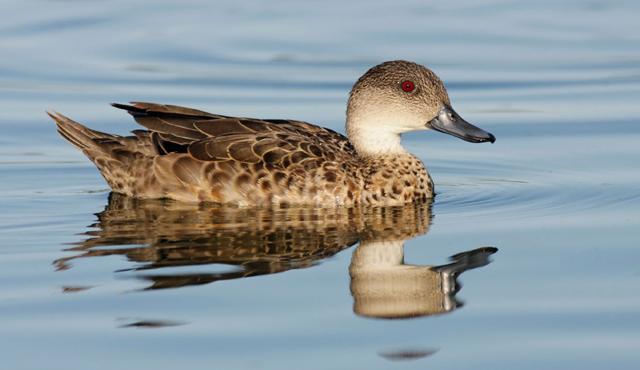
The Grey Teal may look plain at first, but its deep red eyes give it a lively, alert look. Those bright eyes stand out beautifully against its pale face and soft grey-brown feathers.
This small, slim duck is often seen on shallow lakes and wetlands, moving quickly and lightly across the water.
Grey Teals are great travelers—they don’t stay in one place for long. When lakes dry up in one area, they’ll fly hundreds of miles to find new water.
In flight, watch for the quick wingbeats and the flash of white on their wings—a sure sign you’ve spotted one of these active little ducks.
6. Cinnamon Teal (Anas cyanoptera)
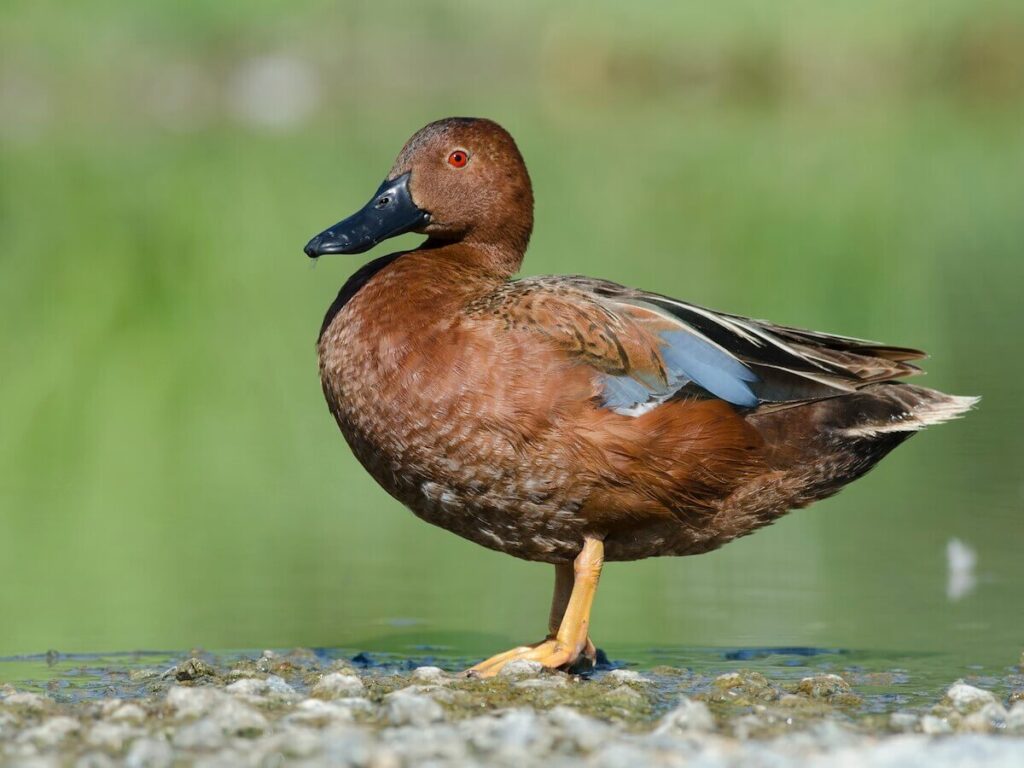
With their glowing red eyes and rich cinnamon-colored feathers, male Cinnamon Teals are a real treat to see.
The male’s rusty-red body and dark bill make him easy to recognize, while the female is a softer brown but still shares that same bright red gaze.
These ducks love calm ponds and marshes, where they paddle along the surface, dipping their bills to scoop up seeds and insects.
When they open their wings, you’ll notice a lovely sky-blue patch that flashes in the sunlight. They often feed together in small flocks, moving in the same direction like a group of friends exploring the water.
7. Red-crested Pochard (Netta rufina)
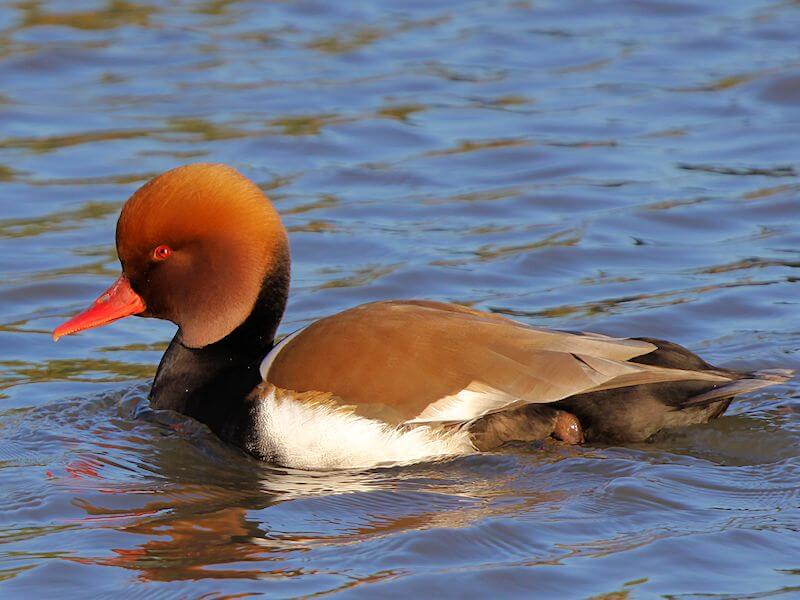
You can’t miss a Red-crested Pochard—it’s one of the most eye-catching ducks around.
The male has glowing red eyes, a matching red bill, and a bright orange head that almost seems to shine in the sun.
His chest is black, his sides white, and his back a warm brown, giving him a smart, well-dressed look.
The female is softer in color, mostly light brown, with dark eyes and a grey bill. She may look plainer, but her calm, gentle beauty is just as appealing.
These ducks love lakes and slow rivers, where they dive for plants and rest on the water’s edge in peaceful groups.
8. Red-breasted Merganser (Mergus serrator)
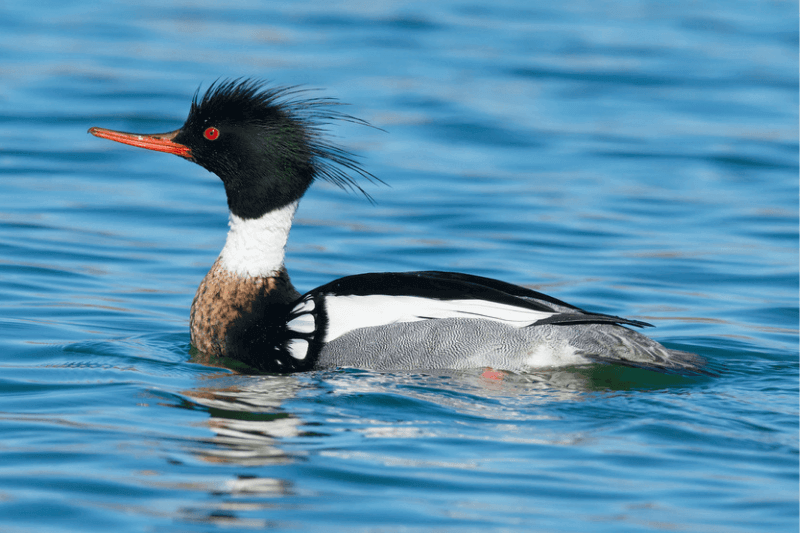
The Red-breasted Merganser is a bold-looking duck with fierce red eyes that match its fiery personality.
The male has a wild, spiky crest and a long, thin bill made for catching fish—he’s a skilled hunter beneath the water’s surface. His chest is reddish, his back dark, and his body patterned with white and grey.
The female looks similar but has softer brown tones and the same sharp shape.
These ducks are built for speed and diving, chasing fish through cold northern lakes, rivers, and coastal waters. If you ever see one swimming with its crest blowing in the wind, you’ll know why it’s one of the most exciting ducks to watch.
9. Common Pochard
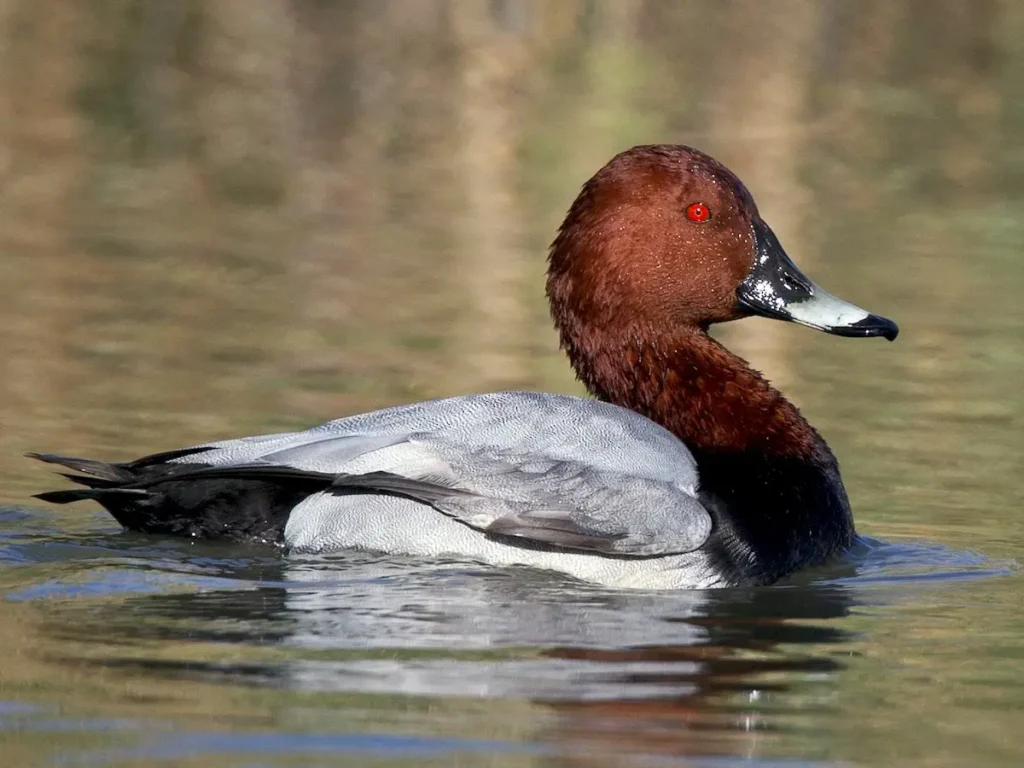
Striking red eyes, vibrant plumage, and an impressive diving ability—there’s a lot to love about the Common Pochard. These handsome ducks brighten up lakes and wetlands across Europe and Asia, especially during breeding season when the males show off their deep chestnut-red heads, black breasts, and silvery-grey bodies.
Females, with their subtle brownish-grey tones, are just as charming in their own quiet way.
Common Pochards are long-distance travelers, flying from northern and eastern Europe to warmer regions in the west, south, and even as far as North Africa for the winter. Some adventurous groups continue all the way to India and Japan.
They’re expert divers, feeding on aquatic plants, seeds, and tiny invertebrates—proof that healthy wetlands mean healthy pochards.
Sadly, they face ongoing threats from habitat loss, hunting, and pollution, but thanks to dedicated conservation efforts, these stunning ducks still have hope for a bright future.
10. White-winged Duck (Asarcornis scutulata)
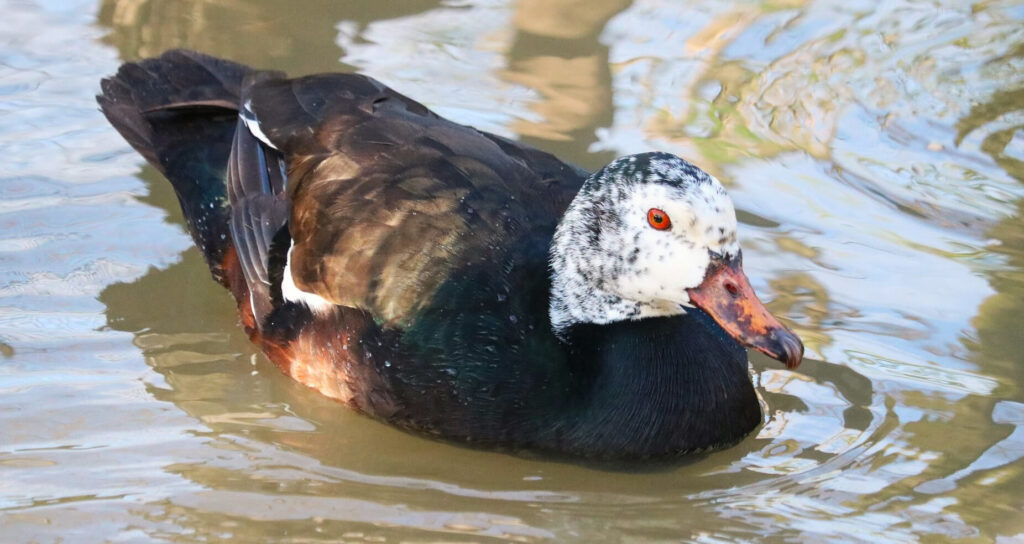
Shy, secretive, and striking, the White-winged Duck is one of the world’s rarest and largest duck species. With its dark body and distinctive white patches on the head and wings, it looks almost like it stepped out of a storybook.
Adults have bold red or orange eyes that stand out beautifully against their contrasting plumage—a feature that develops as the duckling grows toward its first winter.
This elusive bird prefers quiet, forested waterways where it can stay out of sight, emerging mainly at dawn and dusk.
It’s a true heavyweight among ducks, rivaled only by the Muscovy and steamer ducks. Males tend to be larger, with dull yellowish bills and less mottling on their heads, while females have denser speckling.
Though their numbers are low, the White-winged Duck remains a powerful symbol of wilderness and resilience in the wetlands it calls home.
